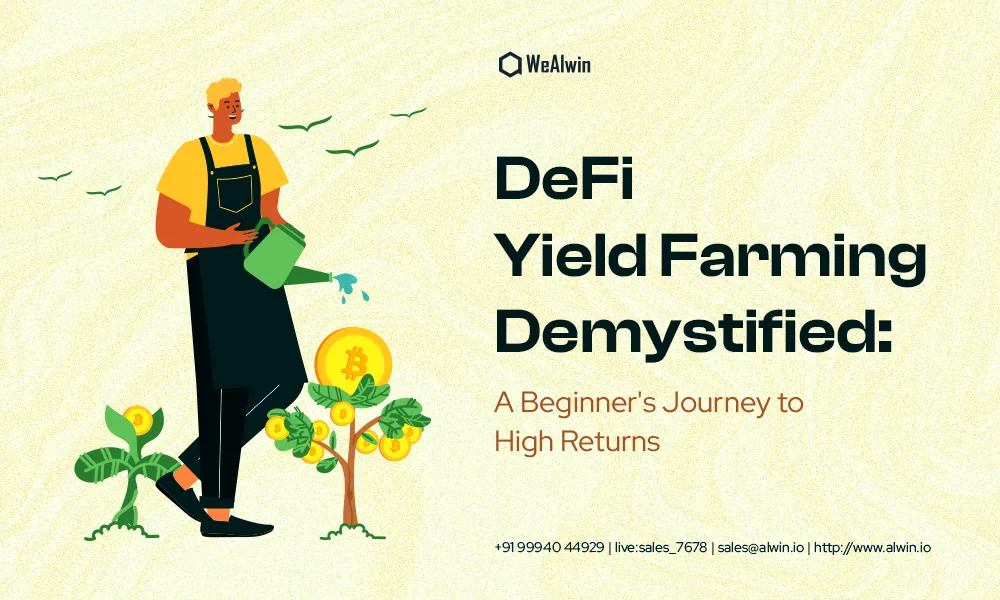Welcome to the world of decentralized finance (DeFi) yield farming platform development!
In this ever-evolving landscape of blockchain and cryptocurrencies, building a DeFi yield farming platform opens up a world of opportunities for both users and developers alike.
Whether you're an aspiring entrepreneur, an enthusiast, or curious about the exciting realm of DeFi, this blog will explore you with insights into the captivating world of DeFi yield farming platform development.
As the demand for decentralized finance solutions continues to surge,
It has emerged as a prominent and lucrative avenue for crypto enthusiasts to earn passive income.
By creating a platform, you can unlock the potential to empower individuals to maximize the value of their digital assets and actively participate in this ecosystem.
So, get ready to dive into the fascinating realm of DeFi yield farming platform development,
Let’s start with,
What is DeFi yield farming?
DeFi yield farming refers to the process of generating returns on cryptocurrency holdings by participating in liquidity provision activities on decentralized platforms.
In simple terms, It involves lending or staking your cryptocurrencies in these liquidity pools, and in return, you earn additional tokens as rewards.
The process is often automated and governed by smart contracts, which remove the need for intermediaries, making it a decentralized and transparent system.
Now,
DeFi Yield Farming App
To enhance user accessibility and convenience, dedicated DeFi yield farming apps have emerged. These apps provide a user-friendly interface for easily depositing assets, selecting liquidity pools, and tracking rewards.
They aim to simplify the process and offer additional features such as analytics, portfolio management, and personalized recommendations for optimal strategies.
Various yield farming apps are UniSwap, PancakeSwap, SushiSwap, and Binance.
How Does Yield Farming Work in DeFi?
DeFi yield farming operates by connecting liquidity providers and borrowers within this ecosystem. Users deposit their cryptocurrencies into liquidity pools, which are utilized for transactions and provide liquidity to decentralized exchanges or other DeFi applications.
These rewards can come in the form of interest on your deposits, transaction fees, or governance tokens issued by the protocol.
Smart contracts govern the process, ensuring secure and transparent execution. Rewards are distributed based on users' contributions to the liquidity pool.
Here are the steps to understand how it works:
Step 1: Selecting a Yield Farming Platform
First choose a platform that offers yield farming opportunities. Popular platforms include Compound, Aave, and Yearn Finance. Research their security, reputation, and available farming options.
Step 2: Depositing Funds
To start yield farming, you need to deposit your cryptocurrencies into the chosen platform's smart contract. Typically, you'll need to provide liquidity by depositing tokens into a liquidity pool.
Step 3: Choosing a Farming Strategy
Select the farming strategy that suits your goals. Different strategies involve different risks and potential rewards.
For example, you may lend or stake your tokens to earn interest or participate in liquidity provisions for decentralized exchanges.
Step 4: Yield Farming Rewards
When you deposit your tokens into a liquidity pool or perform other farming activities, you earn rewards.
These rewards can be in the form of additional tokens, fees generated by the protocol, or governance tokens that grant voting rights.
Step 5: Monitoring and Managing
Keep track of your farming activities regularly. Check the performance of your investments, the accrued rewards, and any changes in the platform's protocols.
Stay informed about potential risks and adjust your strategy accordingly.
Step 6: Harvesting and Reinvesting
Once you've earned rewards, you can choose to harvest them. Harvesting involves withdrawing your earned tokens from the platform. You can then reinvest them in other farming opportunities or convert them to other cryptocurrencies.
Step 7: Managing Risks
Yield farming comes with risks, including smart contract vulnerabilities, impermanent losses, and market volatility.
Educate yourself about these risks and consider diversifying your investments to mitigate potential losses.
Step 8: Research and Stay Informed
The DeFi space is continuously evolving, with new projects and strategies emerging regularly. Stay updated with the latest news, industry trends, and security practices to make informed decisions.
However, by carefully assessing the risks and rewards, and utilizing strategies that align with their goals and risk tolerance, users can potentially earn attractive returns through yield farming.
Types of DeFi yield farming:
Liquidity Mining: Liquidity mining involves providing liquidity to decentralized exchanges (DEXs) or automated market maker (AMM) platforms.
Users contribute their tokens to liquidity pools, and in return, they receive liquidity provider (LP) tokens.
These LP tokens can be staked or deposited in other protocols to earn additional rewards.
Staking: Staking involves holding and locking a particular cryptocurrency in a designated staking wallet or smart contract.
By doing so, participants support the network's operations and security. In return, they earn staking rewards in the form of additional tokens or fees generated by the network.
Lending and Borrowing: Some platforms allow users to lend their cryptocurrencies to borrowers and earn interest on the loans.
Lenders provide liquidity to the platform, and borrowers pay interest for borrowing the funds. This allows individuals to earn passive income by lending their idle assets.
Benefits of yield farming in DeFi
It offers several benefits, including:
1. Higher Returns: It has the potential for higher returns compared to traditional savings accounts or traditional investment options.
By participating in various farming strategies, such as lending, staking, or providing liquidity, users can earn additional tokens, fees, or interest on their holdings.
2. Liquidity Provision: This often involves providing liquidity to decentralized exchanges or lending platforms. By contributing to liquidity pools, users help ensure the smooth functioning of these platforms and earn rewards in return.
This liquidity provision can also facilitate efficient trading and borrowing within the ecosystem.
3. Diversification: It allows users to diversify their crypto holdings and investments. Instead of merely holding a single cryptocurrency, users can allocate their funds to different farming strategies, protocols, or tokens.
This diversification can potentially reduce risk and provide exposure to multiple assets and opportunities.
4. Accessibility and Openness: it is typically open to anyone with an internet connection and compatible digital assets.
It removes barriers to entry, allowing individuals from various backgrounds to participate in earning rewards and benefiting from the decentralized financial ecosystem.
This inclusivity promotes financial empowerment and equal opportunities for users worldwide.
5. Programmability and Automation: Often rely on smart contracts, which enable the automation of financial transactions and operations.
Users can set up automated strategies, such as reinvesting earned tokens or compounding returns, without requiring constant manual intervention.
This programmability enhances convenience and efficiency in managing your activities.
6. Governance Participation: Many platforms issue governance tokens to users who participate in yield farming.
These tokens grant holders voting rights and the ability to influence platform decisions, such as protocol upgrades, fee structures, or new features.
It allows users to actively participate in shaping the future of the DeFi platforms they are involved in.
7. Transparency and Audibility: It is built on public blockchains, providing transparent and auditable transaction records. Users can verify the integrity of the smart contracts, track their rewards, and assess the security of the platforms.
This transparency enhances trust and reduces the reliance on intermediaries.
It's important to note that while offers attractive benefits, it also carries risks. Users should carefully evaluate the platforms, strategies, and associated risks before participating.
Final words,
DeFi yield farming presents an exciting opportunity for individuals to dive headfirst into the decentralized finance ecosystem, actively contributing liquidity and reaping rewards on their cryptocurrency holdings.
Ready to revolutionize your yield farming startup journey and make waves in the ever-evolving world of DeFi? Look no further! We at WeAlwin Technologies are here to assist you every step of the way.
Don't let lucrative opportunities slip through your fingers! With our cutting-edge DeFi solutions and expert guidance, you can embark on your startup venture with confidence.
We're eager to share our knowledge and support your success.
Seize the moment and take full advantage of the abundant possibilities that await you. There's no better time than now to kick-start your startup journey with WeAlwin Technologies.



